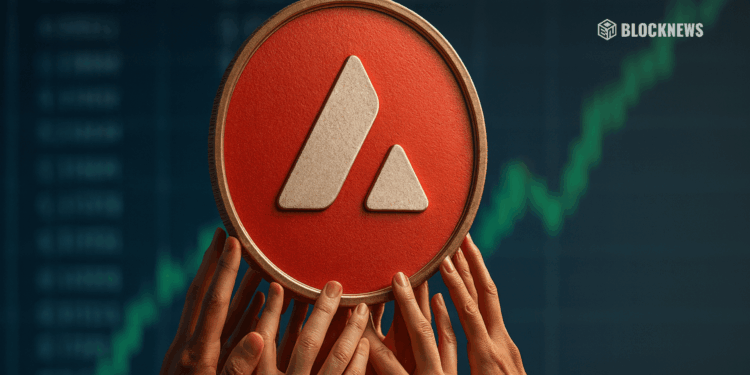- Avalanche plans a $1B AVAX buyback while RWAs on the network surged past $400M, boosting adoption.
- Subnets give enterprises tailored blockchain solutions, making AVAX attractive to institutions.
- Retail buzz, institutional attention, and scarcity dynamics position Avalanche for a strong Q4 comeback.
The market runs on stories. Lately, Avalanche (AVAX) is writing a loud one—search interest climbing, institutions peeking over the fence, and a community that suddenly feels… awake. Between talk of a $1B raise to buy back AVAX and a burst of real-world assets (RWA) crossing the $400M mark, the chain looks like a dark horse building steam into Q4. Not hype-for-hype’s sake; there’s meat here.
Let’s lay it out clean: what Avalanche is, why it moves differently, the money narrative (buybacks), the RWA surge, and the momentum signals that have both retail and suits watching.
What Avalanche Is and Why it Cctually Matters
Avalanche is a Layer-1 built for speed and parallelism. Sub-second finality—yes, genuinely quick—and a consensus design that samples validators repeatedly instead of marching through slow, global agreement. The result: thousands of transactions per second while keeping decentralization in the picture.
The architecture’s the sneaky edge:
- X-Chain — asset creation & transfers.
- C-Chain — Ethereum-compatible smart contracts; solidity devs feel at home.
- P-Chain — validators, staking, and subnets (custom blockchains that plug into the whole).
Subnets are the unlock. Teams can spin up their own chain—with their own rules, fees, tokens, even compliance knobs—without elbowing for blockspace on the main lane. That’s catnip for enterprises, institutions, governments who want control, but also want a big network behind them.
At the center is $AVAX. It pays fees, secures the network via staking, and takes part in governance. Fee burn is permanent (gone forever), and total supply is hard-capped at 720M. Scarcity + burn + usage = a very simple story investors actually remember.
The $1B Buyback Push
The headline: a plan to raise $1 billion through crypto treasury firms to buy back AVAX. Sounds aggressive. It is.
Mechanics in plain words:
- Treasury partners get funding and scoop AVAX (often at negotiated terms).
- Those tokens move off the open market, deepening liquidity for big players and tightening float for everyone else.
- Combine that with fee burn and a fixed cap, and you’ve stacked two scarcity levers on one token
This isn’t just price scaffolding; it’s a signal. Projects don’t chase a billion in buybacks if they’re playing defense. It’s Avalanche saying: we’re building a foundation now for the heavy traffic we expect later. If the ecosystem keeps growing, that raise acts like rocket fuel—especially when paired with sticky use cases (RWAs, subnets, pro dApps).
RWAs on Avalanche: The Flywheel You Can’t Ignore
Here’s where things get real (literally). Tokenized treasuries, real estate, yield products—RWAs on Avalanche blasted past $400M in the last month, up ~115%. That’s not a weekend pump; that’s adoption.
Why Avalanche for RWAs?
- Subnets let issuers tailor environments (permissions, KYC zones, compliance settings) while keeping Avalanche’s speed.
- C-Chain compatibility keeps on-ramps simple, tooling familiar.
- Finality is fast enough that institutions don’t have to pretend they enjoy waiting.
RWAs bring sticky demand. These aren’t degen flips; they’re programs, issuances, and flows that run for quarters—years even. More RWA = more transactions = more AVAX burned = tighter supply pressure over time. Quiet flywheel, strong effect.
Momentum Signals: Retail Wakes Up, Institutions Lean in
- Search spikes: Google Trends for “Avalanche” and “AVAX” has been climbing. When retail starts typing, liquidity usually follows, then headlines… then more typing.
- Institutional attention: the $1B raise + a swelling RWA book puts AVAX on the shortlist for desks that want L1 exposure beyond ETH/SOL.
- Social chatter: more mentions, cleaner sentiment. Traders are openly gaming an “AVAX rotation” in the next alt leg. That’s how feedback loops begin.
Catalysts stacking into Q4: buybacks, RWA growth, public interest. It’s a neat three-piece suit.
Token Mechanics (the simple part people forget)
- Hard cap: 720,000,000 AVAX.
- Burn: all base fees are burned; usage shrinks supply over time.
- Staking: security + rewards; aligned with network health.
- Governance: parameter changes, economic tweaks—longer-arc decisions.
Small note that matters: deflationary pressure isn’t deflation by default—it scales with activity. Avalanche’s bet is that subnets + RWAs + DeFi/NFT cycles keep activity high enough for burn to be meaningful. In hot markets, that math hits different.
Where the Edges Actually are the Risks
Edges
- Subnets give Avalanche a “build your own lane” story competitors can’t easily clone.
- RWA traction = credibility with suits, not just CT.
- A buyback war chest sends a confidence shock through the market.
Risks
- Execution risk on the buyback structure; if it’s slow/confusing, the signal dulls.
- RWA scaling needs real compliance rails; headlines can whiplash sentiment.
- Competing L1s will chase the same pie with incentives of their own, fast
Bottom Line
Avalanche is ticking the boxes: speed, subnets, hard cap + burn, $1B buyback plan, and a $400M+ RWA wave that looks early, not late. Retail is sniffing around, institutions are lining up calls, and the narrative—“AVAX as the home for tokenized assets + tailored chains”—is crisp enough to travel.
Is it perfect? nope. Nothing is. But for the first time in a while, the setup going into Q4 looks like more than a mood swing. If the trend holds, AVAX isn’t just another L1 trying to keep up—it’s a contender carving out a lane where real-world money and on-chain speed actually meet.
Strong hands watch fundamentals. Fast hands watch momentum. Right now, Avalanche has both staring at it.














